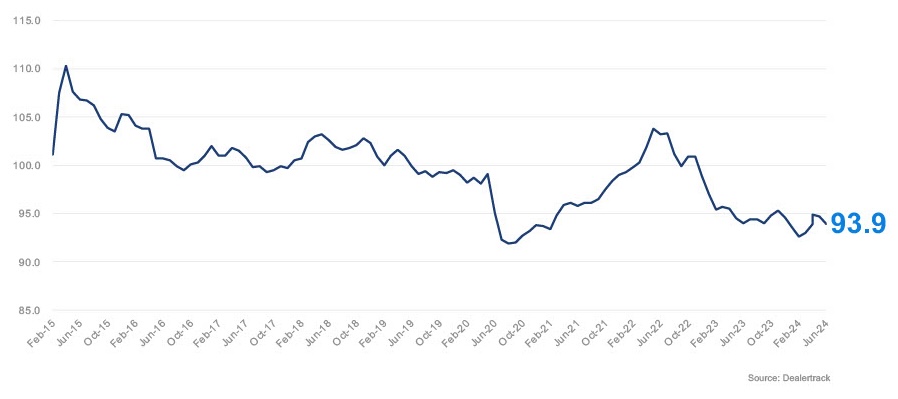Data Point
Auto Credit Availability Declined in June
Wednesday July 10, 2024
Access to auto credit declined again in June as credit tightened across all channels and all lender types, according to the Dealertrack Credit Availability Index. The All-Loans Index was 93.9 in June, down 0.8 from a downwardly revised May reading and down 0.5% year over year.
Dealertrack Credit Availability Index1
Auto loan access worsened slightly in June and was down year over year
All Auto Loans Index (Jan2019=100)

Several factors contributed to making credit access more challenging for consumers. Approval rates declined, yield spreads increased, and the share of negative equity decreased. However, the proportions of subprime loans and term lengths remained stable month over month, having no significant impact on consumer credit access. A slight decrease in down payment shares was the only factor that positively influenced credit access.
In June, credit access tightened across all channels compared to the previous year, except for independent used-car sales, which saw some loosening. Year over year, credit access declined for all lender types except for auto-focused finance companies. Among the various channels, used loans from franchised dealers experienced the least tightening for the month, while new loans showed the most significant tightening. Credit unions faced the greatest tightening of standards, whereas auto-focused finance companies experienced the least tightening.
June’s Credit Availability Factors Mixed
June brought a mixed bag of changes in credit availability factors. While the approval rate decreased and yield spreads widened, the amount of negative equity declined and down payments also decreased, which was a positive change for consumers. The subprime share and term lengths remained unchanged, which means that there was no additional impact on consumer credit access from these factors. This is significant as it indicates that despite other tightening measures, these factors did not worsen the credit access situation for consumers.
By channel, used loans through franchised dealers saw the least tightening, while new loans saw the most amount of tightening. On a year-over-year basis, improvement was seen only by used loans from independent dealers, which loosened, while credit availability for certified pre-owned loans tightened the most. Among lenders, all lenders tightened in June compared to May and credit unions pulled back the most for the month, while auto-focused finance companies loosened the least year over year.
In June, the average yield spread on auto loans grew by 15 basis points (BPs), making the rates consumers saw on auto loans less attractive relative to bond yields. This significant increase should raise concerns about the affordability of auto loans for consumers. The average auto loan rate decreased by 3 BPs in June compared to May, while the 5-year U.S. Treasury decreased by 18 BPs, resulting in a larger average observed yield spread. This means that consumers are now paying a higher premium for auto loans compared to the bond market, which could impact their affordability.
The approval rate decreased by 80 BPs in May but was down 3.0 percentage points year over year. The subprime share was flat in June and was up 1.8 percentage points year over year.
The share of loans with greater than 72-month terms was also flat but was down 1.8 percentage points year over year.
In June, sales channels saw tightening credit availability. New loans saw the most tightening, while franchised used loans saw the least. On a year-over-year basis, used loans through independent dealers showed loosening, and used certified pre-owned loans saw the most tightening conditions compared to the same time last year.
Credit Availability Was Down Across All Lender Types in June
Credit availability was down in June for all lender types. Auto-focused finance companies tightened the least, while credit unions saw the most tightening again. On a year-over-year basis, credit access was loosened for finance companies, while credit unions saw the most tightening.
Each Dealertrack Auto Credit Index tracks shifts in loan approval rates, subprime share, yield spreads and loan details, including term length, negative equity, and down payments. The index is baselined to January 2019 to provide a view of how credit access shifts over time.
Measures of Consumer Confidence Were Mixed in June
The Conference Board Consumer Confidence Index® declined 0.9% in June, as views of the future declined more than views of the present improved. Consumer confidence was down 8.8% year over year. Plans to purchase a vehicle in the next six months declined compared to May but was higher than June last year. According to the sentiment index from the University of Michigan, consumer sentiment declined 1.3% in June compared to May but was up 6.2% year over year. The median consumer expectation for inflation in a year declined to 3.0%, which was the lowest level in three months, but the expectation for 5 years was steady at 3.0%. The consumer’s view of buying conditions for vehicles declined to the lowest level since November as the view of interest rates and prices deteriorated. The daily index of consumer sentiment from Morning Consult was less volatile in June and ended up 0.6%, leaving the index up 3.0% year over year. Gas prices declined in June, but gas prices rose in the last week of the month. The national average price for unleaded gas from AAA was down 1.5% from the end of May to $3.49 per gallon as of June 30, which was down 1% year over year but up 1.2% over the last week.
The Dealertrack Credit Availability Index is a monthly index based on Dealertrack credit application data and will indicate whether access to auto loan credit is improving or worsening. The index will be published around the 10th of each month.
1In November 2023, the data behind the Dealertrack Auto Credit Availability Index was reset by our data sciences team as part of a migration to a new data management system. All points in the data set were reestablished, with January 2019 in the index set at 100 (as it had been previously). The All-Loans Index plot used in this post utilizes the new data set. The absolute numbers have shifted, but the trends and narrative have not. For more information, contact the Cox Automotive team.
Jonathan Gregory
Jonathan Gregory is a Senior Manager on Cox Automotive’s economic and industry insights team, which works to find actionable insights for the industry posed by Cox Automotive clients. Jonathan works with the Sales, Finance, and Data Science organizations and creates innovative solutions often combining proprietary data from other Cox Automotive brands. Jonathan joined Cox Automotive in 2022.

